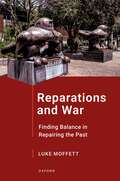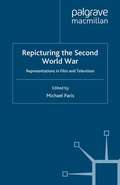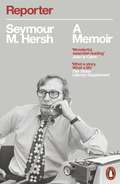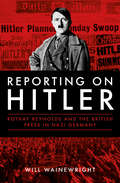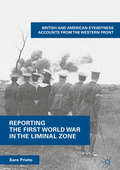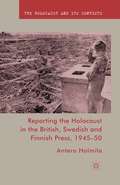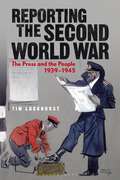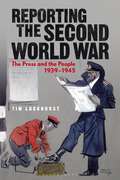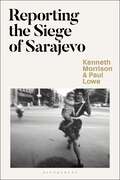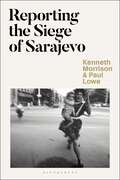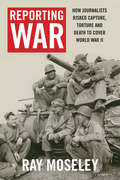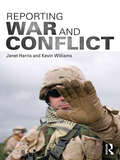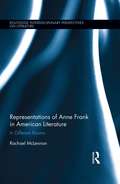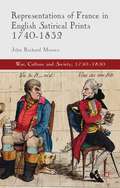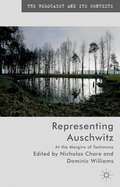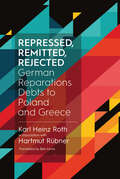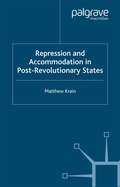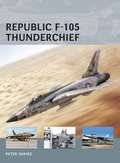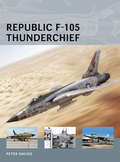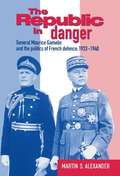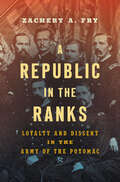- Table View
- List View
Reparations and War: Finding Balance in Repairing the Past
by Luke MoffettWar devastates the lives of those who are caught up in it. For thousands of years, reparations have been used to secure the end of war and alleviate its deleterious consequences. More recently, human rights law has established that victims have a right to reparations. Yet, in the face of conflicts that last for decades with millions of victims, how feasible are reparations? And what are the obstacles to delivering them? Using interviews with hundreds of victims, ex-combatants, government officials, and civil society actors from six post-conflict countries, Reparations and War examines the history, theoretical justifications, and practical challenges of implementing reparations after war. It examines the role of non-state armed groups in making reparations, the role of victim mobilisation, the evolving use of reparations, and the political instrumentalization of redress. Luke Moffett offers a measured and honest account of what reparations can and cannot do. This book sheds new light on how reparations can be politically manipulated, or used to reward those loyal to the State, rather than to achieve justice for the victims who suffer.
Repicturing the Second World War: Representations in Film and Television
by Michael ParisFilms and television dramas about the Second World War have always been popular. Written by acknowledged experts in the field, this collection offers challenging, sometimes controversial, insights into how the popular memory of the Second World War has been 're-pictured' since 1989, which marked the sixtieth anniversary of the start of the war.
Reporter: A Memoir
by Seymour M. Hersh'Reporter is just wonderful. Truly a great life, and what shines out of the book, amid the low cunning and tireless legwork, is Hersh's warmth and humanity. Essential reading for every journalist and aspiring journalist the world over' John le CarréIn the early 1950s, teenage Seymour Hersh was finishing high school and university - while running the family's struggling dry cleaning store in a Southside Chicago ghetto. Today, he is one of America's premier investigative journalists, whose fearless reporting has earned him fame, front-page bylines in virtually every newspaper in the world, a staggering collection of awards, and no small amount of controversy.Reporter is the story of how he did it. It is a story of slog, ingenuity and defiance, following Hersh from his first job as a crime reporter for the Chicago City News Bureau, through his Pulitzer Prize-winning freelance investigative exposes, to the heights of his reporting for The New York Times and the New Yorker. It is a tale of night-time encounters with great Civil Rights leaders, unauthorised meetings with Pentagon officials, raucous dinners with Canadian soldiers in Hanoi, tense phone calls with Secretaries of State, desperate to save face; of exposing myriad military and political wrongdoing, from My Lai to Watergate to Abu Ghraib, and the cynical cover-ups that followed in Washington and New York. Here too are unforgettable encounters with some of the most formidable figures from recent decades, from Saul Bellow to Martin Luther King Jr., from Henry Kissinger to Bashar al-Assad.Ultimately, in unfurling Seymour Hersh's life and career, Reporter tells a story of twentieth-century America, in all its excitement and darkness.
Reporting on Hitler: Rothay Reynolds and the British Press in Nazi Germany
by Will WainewrightAllegedly the only man capable of holding the Führer's intense gaze, Rothay Reynolds was a leading foreign correspondent between the wars and ran the Daily Mail's bureau in Berlin throughout the 1920s and 1930s. The enigmatic former clergyman was one of the first journalists to interview Adolf Hitler, meeting the future Führer days before the Munich Putsch.While the awful realities of the Third Reich were becoming apparent on the ground in Germany, in Britain the Daily Mail continued to support the Nazi regime. Reynolds's time as a foreign correspondent in Nazi Germany provides some startling insights into the muzzling of the international press prior to the Second World War, as journalists walked uneasy tightropes between their employers' politics and their own journalistic integrity. As war approached, the stakes - and the threats from the Gestapo - rose dramatically.Reporting on Hitler reveals the gripping story of Rothay Reynolds and the intrepid foreign correspondents who reported on some of the twentieth century's most momentous events in the face of sinister propaganda, brazen censorship and the threat of expulsion - or worse - if they didn't toe the Nazis' line. It uncovers the bravery of the forgotten heroes from a golden age of British journalism, who risked everything to tell the world the truth.
Reporting the First World War in the Liminal Zone: British and American Eyewitness Accounts from the Western Front
by Sara PrietoThis book deals with an aspect of the Great War that has been largely overlooked: the war reportage written based on British and American authors’ experiences at the Western Front. It focuses on how the liminal experience of the First World War was portrayed in a series of works of literary journalism at different stages of the conflict, from the summer of 1914 to the Armistice in November 1918.Sara Prieto explores a number of representative texts written by a series of civilian eyewitness who have been passed over in earlier studies of literature and journalism in the Great War. The texts under discussion are situated in the ‘liminal zone’, as they were written in the middle of a transitional period, half-way between two radically different literary styles: the romantic and idealising ante bellum tradition, and the cynical and disillusioned modernist school of writing. They are also the product of the various stages of a physical and moral journey which took several authors into the fantastic albeit nightmarish world of the Western Front, where their understanding of reality was transformed beyond anything they could have anticipated.
Reporting the First World War in the Liminal Zone (PDF): British and American Eyewitness Accounts from the Western Front
by Sara PrietoThis book deals with an aspect of the Great War that has been largely overlooked: the war reportage written based on British and American authors’ experiences at the Western Front. It focuses on how the liminal experience of the First World War was portrayed in a series of works of literary journalism at different stages of the conflict, from the summer of 1914 to the Armistice in November 1918.Sara Prieto explores a number of representative texts written by a series of civilian eyewitness who have been passed over in earlier studies of literature and journalism in the Great War. The texts under discussion are situated in the ‘liminal zone’, as they were written in the middle of a transitional period, half-way between two radically different literary styles: the romantic and idealising ante bellum tradition, and the cynical and disillusioned modernist school of writing. They are also the product of the various stages of a physical and moral journey which took several authors into the fantastic albeit nightmarish world of the Western Front, where their understanding of reality was transformed beyond anything they could have anticipated.
Reporting the Holocaust in the British, Swedish and Finnish Press, 1945-50 (The Holocaust and its Contexts)
by A. HolmilaExamining how the press in Britain, Sweden and Finland responded to the Holocaust immediately after the Second World War, Holmila offers new insights into the challenge posed by the Holocaust for liberal democracies by looking at the reporting of the liberation of the camps, the Nuremberg trial and the Jewish immigration to Palestine.
Reporting the Second World War: The Press and the People 1939-1945
by Tim LuckhurstThe decisive role of Britain's wartime newspaper journalism in shaping public opinion and government policy has been majorly overlooked. Much of the existing historiography has framed Britain's newspapers as mouthpieces of state propaganda, readily conforming to the wishes of the wartime coalition. Tim Luckhurst challenges this through an analysis of illuminating and largely forgotten controversies which underscore the function the press held as guardians of democracy and propagators of dissenting opinion in British politics and society - from the overseas evacuation of children to the Allies' carpet bombing of German cities.Reporting the Second World War is a timely and important intervention that duly recognises the place of national, regional and specialist titles in speaking truth to power in a democracy at war.
Reporting the Second World War: The Press and the People 1939-1945
by Tim LuckhurstThe decisive role of Britain's wartime newspaper journalism in shaping public opinion and government policy has been majorly overlooked. Much of the existing historiography has framed Britain's newspapers as mouthpieces of state propaganda, readily conforming to the wishes of the wartime coalition. Tim Luckhurst challenges this through an analysis of illuminating and largely forgotten controversies which underscore the function the press held as guardians of democracy and propagators of dissenting opinion in British politics and society - from the overseas evacuation of children to the Allies' carpet bombing of German cities.Reporting the Second World War is a timely and important intervention that duly recognises the place of national, regional and specialist titles in speaking truth to power in a democracy at war.
Reporting the Siege of Sarajevo
by Kenneth Morrison Paul LoweThe Siege of Sarajevo remains the longest siege in modern European history, lasting three times longer than the Battle of Stalingrad and over a year longer than the Siege of Leningrad. Reporting the Siege of Sarajevo provides the first detailed account of the reporting of this siege and the role that journalists played in highlighting both military and non-military aspects of it. The book draws on detailed primary and secondary material in English and Bosnian, as well as extensive interviews with international correspondents who covered events in Sarajevo from within siege lines. It also includes hitherto unpublished images taken by the co-author and award-winning photojournalist, Paul Lowe.Together Morrison and Lowe document a relatively short but crucial period in both the history of Bosnia & Herzegovina, the city of Sarajevo and the profession of journalism. The book provides crucial observations and insights into an under-researched aspect of a critical period in Europe's recent history.
Reporting the Siege of Sarajevo
by Kenneth Morrison Paul LoweThe Siege of Sarajevo remains the longest siege in modern European history, lasting three times longer than the Battle of Stalingrad and over a year longer than the Siege of Leningrad. Reporting the Siege of Sarajevo provides the first detailed account of the reporting of this siege and the role that journalists played in highlighting both military and non-military aspects of it. The book draws on detailed primary and secondary material in English and Bosnian, as well as extensive interviews with international correspondents who covered events in Sarajevo from within siege lines. It also includes hitherto unpublished images taken by the co-author and award-winning photojournalist, Paul Lowe.Together Morrison and Lowe document a relatively short but crucial period in both the history of Bosnia & Herzegovina, the city of Sarajevo and the profession of journalism. The book provides crucial observations and insights into an under-researched aspect of a critical period in Europe's recent history.
Reporting War: How Foreign Correspondents Risked Capture, Torture and Death to Cover World War II
by Ray MoseleyLuminary journalists Ed Murrow, Martha Gellhorn, Walter Cronkite, and Clare Hollingworth were among the young reporters who chronicled World War II’s daily horrors and triumphs for Western readers. In this fascinating book, Ray Moseley, himself a former foreign correspondent who encountered a number of these journalists in the course of his long career, mines the correspondents’ writings to relate, in an exhilarating parallel narrative, the events across every theater—Europe, Pearl Harbor, North Africa, and Japan—as well as the lives of the courageous journalists who doggedly followed the action and the story, often while embedded in the Allied armies. Moseley’s broad and intimate history draws on newly unearthed material to offer a comprehensive account both of the war and the abundance of individual stories and overlooked experiences, including those of women and African-American journalists, which capture the drama as it was lived by reporters on the front lines of history.
Reporting War and Conflict
by Kevin Williams Janet HarrisReporting War and Conflict brings together history, theory and practice to explore the issues and obstacles involved in the reporting of contemporary war and conflict. The book examines the radical changes taking place in the working practices and day-today routines of war journalists, arguing that managing risk has become central to modern war correspondence. How individual reporters and news organisations organise their coverage of war and conflict is increasingly shaped by a variety of personal, professional and institutional risks. The book provides an historical and theoretical context to risk culture and the work of war correspondents, paying particular attention to the changing nature of technology, organisational structures and the role of witnessing. The conflicts in Iraq, Afghanistan and Syria are examined to highlight how risk and the calculations of risk vary according to the type of conflict. The focus is on the relationship between propaganda, censorship, the sourcing of information and the challenges of reporting war in the digital world. The authors then move on to discuss the arguments around risk in relation to gender and war reporting and the coverage of death on the battlefield. Reporting War and Conflict is a guide to the contemporary changes in warfare and the media environment that have influenced war reporting. It offers students and researchers in journalism and media studies an invaluable overview of the life of a modern war correspondent.
Reporting War and Conflict (PDF)
by Kevin Williams Janet HarrisReporting War and Conflict brings together history, theory and practice to explore the issues and obstacles involved in the reporting of contemporary war and conflict. The book examines the radical changes taking place in the working practices and day-today routines of war journalists, arguing that managing risk has become central to modern war correspondence. How individual reporters and news organisations organise their coverage of war and conflict is increasingly shaped by a variety of personal, professional and institutional risks. The book provides an historical and theoretical context to risk culture and the work of war correspondents, paying particular attention to the changing nature of technology, organisational structures and the role of witnessing. The conflicts in Iraq, Afghanistan and Syria are examined to highlight how risk and the calculations of risk vary according to the type of conflict. The focus is on the relationship between propaganda, censorship, the sourcing of information and the challenges of reporting war in the digital world. The authors then move on to discuss the arguments around risk in relation to gender and war reporting and the coverage of death on the battlefield. Reporting War and Conflict is a guide to the contemporary changes in warfare and the media environment that have influenced war reporting. It offers students and researchers in journalism and media studies an invaluable overview of the life of a modern war correspondent.
Representations of Anne Frank in American Literature: Stories in New Ways (Routledge Interdisciplinary Perspectives on Literature)
by Rachael McLennanThis book explores portrayals of Anne Frank in American literature, where she is often invoked, if problematically, as a means of encouraging readers to think widely about persecution, genocide, and victimisation; often in relation to gender, ethnicity, and race. It shows how literary representations of Anne Frank in America over the past 50 years reflect the continued dominance of the American dramatic adaptations of Frank’s Diary in the 1950s, and argues that authors feel compelled to engage with the problematic elements of these adaptations and their iconic power. At the same time, though, literary representations of Frank are associated with the adaptations; critics often assume that these texts unquestioningly perpetuate the problems with the adaptations. This is not true. This book examines how American authors represent Frank in order to negotiate difficult questions relating to representation of the Holocaust in America, and in order to consider gender, coming of age, and forms of inequality in American culture in various historical moments; and of course, to consider the ways Frank herself is represented in America. This book argues that the most compelling representations of Frank in American literature are alert to their own limitations, and may caution against making Frank a universal symbol of goodness or setting up too easy identifications with her. It will be of great interest to researchers and students of Frank, the Holocaust in American fiction and culture, gender studies, life writing, young adult fiction, and ethics.
Representations of Anne Frank in American Literature: Stories in New Ways (Routledge Interdisciplinary Perspectives on Literature)
by Rachael McLennanThis book explores portrayals of Anne Frank in American literature, where she is often invoked, if problematically, as a means of encouraging readers to think widely about persecution, genocide, and victimisation; often in relation to gender, ethnicity, and race. It shows how literary representations of Anne Frank in America over the past 50 years reflect the continued dominance of the American dramatic adaptations of Frank’s Diary in the 1950s, and argues that authors feel compelled to engage with the problematic elements of these adaptations and their iconic power. At the same time, though, literary representations of Frank are associated with the adaptations; critics often assume that these texts unquestioningly perpetuate the problems with the adaptations. This is not true. This book examines how American authors represent Frank in order to negotiate difficult questions relating to representation of the Holocaust in America, and in order to consider gender, coming of age, and forms of inequality in American culture in various historical moments; and of course, to consider the ways Frank herself is represented in America. This book argues that the most compelling representations of Frank in American literature are alert to their own limitations, and may caution against making Frank a universal symbol of goodness or setting up too easy identifications with her. It will be of great interest to researchers and students of Frank, the Holocaust in American fiction and culture, gender studies, life writing, young adult fiction, and ethics.
Representations of France in English Satirical Prints 1740-1832 (War, Culture and Society, 1750-1850)
by J. MooresBetween 1740 and 1832, England witnessed what has been called its 'golden age of caricature', coinciding with intense rivalry and with war with France. This book shows how Georgian satirical prints reveal attitudes towards the French 'Other' that were far more complex, ambivalent, empathetic and multifaceted than has previously been recognised.
Representing Auschwitz: At the Margins of Testimony (The Holocaust and its Contexts)
by Nicholas Chare and Dominic WilliamsThis collection of essays by leading international scholars takes the Scrolls of Auschwitz as its starting point. These powerful hand-written testimonies, produced within Birkenau, seek to bear witness to mass murder from at its core. The highly literary accounts pose a fundamental challenge to the idea the Holocaust cannot be attested to.
Repressed, Remitted, Rejected: German Reparations Debts to Poland and Greece
by Dr Karl Heinz Roth Hartmut RübnerSince unification, the Federal Republic of Germany has made vaunted efforts to make amends for the crimes of the Third Reich. Yet it remains the case that the demands for restitution by many countries that were occupied during the Second World War are unresolved, and recent demands from Greece and Poland have only reignited old debates. This book reconstructs the German occupation of Poland and Greece and gives a thorough accounting of these debates. Working from the perspective of international law, it deepens the scholarly discourse around the issue, clarifying the ‘never-ending story’ of German reparations policy and making a principled call for further action. A compilation of primary sources comprising 125 annotated key texts (512 pages) on the complexity of reparations discussions covering the period between 1941 and the end of 2017 is available for free on the Berghahn Books website, doi: 10.3167/9781800732575.dd.
Repressed, Remitted, Rejected: German Reparations Debts to Poland and Greece
by Dr Karl Heinz Roth Hartmut RübnerSince unification, the Federal Republic of Germany has made vaunted efforts to make amends for the crimes of the Third Reich. Yet it remains the case that the demands for restitution by many countries that were occupied during the Second World War are unresolved, and recent demands from Greece and Poland have only reignited old debates. This book reconstructs the German occupation of Poland and Greece and gives a thorough accounting of these debates. Working from the perspective of international law, it deepens the scholarly discourse around the issue, clarifying the ‘never-ending story’ of German reparations policy and making a principled call for further action. A compilation of primary sources comprising 125 annotated key texts (512 pages) on the complexity of reparations discussions covering the period between 1941 and the end of 2017 is available for free on the Berghahn Books website, doi: 10.3167/9781800732575.dd.
Repression and Accommodation in Post-Revolutionary States
by M. KrainWe know very little about political dynamics in states that have just experienced an internal war, despite the increasing need to deal with such states in the post-Cold War world. Matthew Krain examines what prompts leaders in post-revolutionary states to employ repression or accommodation. Through statistical analysis and case studies of Iran, Cuba, Nicaragua, and Bolivia, he also examines the effects of these choices on how the domestic opposition reacts, what type of political system develops in the new state, and whether or not the leaders who institute these policies survive in power in the long run. Krain concludes with a series of policy recommendations.
Republic F-105 Thunderchief (Air Vanguard #2)
by Peter E. Davies Adam Tooby Henry MorsheadThe Republic F-105 Thunderchief was the fastest and most successful strike fighter of the Cold War. Designed to deliver nuclear weapons at low altitude and then fight its way back to base, by the early 1960s it was the primary weapon in the USAF's tactical strike arsenal. Thunderchief pilots in Europe, the Far East and the USA stood on short-notice alert, ready to take on the formidable defenses of their Communist Bloc targets. The F-105 was, however, to become a legend in a very different conflict. As direct American involvement in Vietnam increased, F-105s were deployed – initially as a deterrent, but ever more as conventional attack fighters against insurgency in Laos and Vietnam. With the start of the bombing campaign against North Vietnam, the Thunderchief became a vital element in attacks against some of the most heavily defended territory in modern history.
Republic F-105 Thunderchief (Air Vanguard #2)
by Peter E. Davies Adam Tooby Mr Henry MorsheadThe Republic F-105 Thunderchief was the fastest and most successful strike fighter of the Cold War. Designed to deliver nuclear weapons at low altitude and then fight its way back to base, by the early 1960s it was the primary weapon in the USAF's tactical strike arsenal. Thunderchief pilots in Europe, the Far East and the USA stood on short-notice alert, ready to take on the formidable defenses of their Communist Bloc targets. The F-105 was, however, to become a legend in a very different conflict. As direct American involvement in Vietnam increased, F-105s were deployed – initially as a deterrent, but ever more as conventional attack fighters against insurgency in Laos and Vietnam. With the start of the bombing campaign against North Vietnam, the Thunderchief became a vital element in attacks against some of the most heavily defended territory in modern history.
The Republic in Danger: General Maurice Gamelin and the Politics of French Defence, 1933–1940 (PDF)
by Martin S. AlexanderThis is the first full-length study in English of the career of one of France's most controversial military leaders, General Maurice Gamelin (1872–1958). Gamelin was reviled by many of his contemporaries and denigrated by historians as 'the man who lost the Battle of France'. Here Gamelin is re-appraised in the context of the unstable civil-military relations and national decline of the years 1933–40.
A Republic in the Ranks: Loyalty and Dissent in the Army of the Potomac (Civil War America)
by Zachery A. FryThe Army of the Potomac was a hotbed of political activity during the Civil War. As a source of dissent widely understood as a frustration for Abraham Lincoln, its onetime commander, George B. McClellan, even secured the Democratic nomination for president in 1864. But in this comprehensive reassessment of the army's politics, Zachery A. Fry argues that the war was an intense political education for its common soldiers. Fry examines several key crisis points to show how enlisted men developed political awareness that went beyond personal loyalties. By studying the struggle between Republicans and Democrats for political allegiance among the army's rank and file, Fry reveals how captains, majors, and colonels spurred a pro-Republican political awakening among the enlisted men, culminating in the army's resounding Republican voice in state and national elections in 1864.For decades, historians have been content to view the Army of the Potomac primarily through the prism of its general officer corps, portraying it as an arm of the Democratic Party loyal to McClellan's leadership and legacy. Fry, in contrast, shifts the story's emphasis to resurrect the successful efforts of proadministration junior officers who educated their men on the war's political dynamics and laid the groundwork for Lincoln's victory in 1864.
